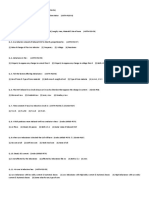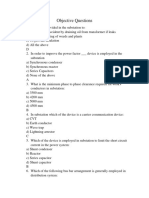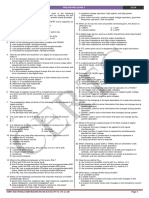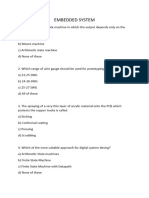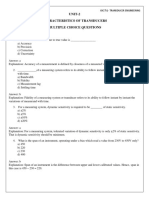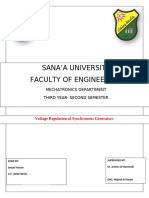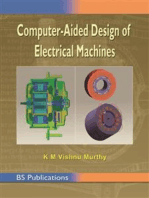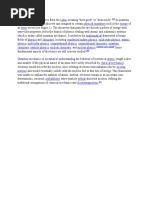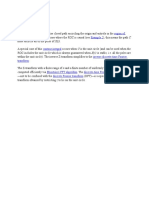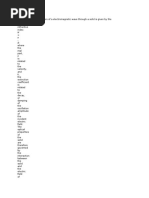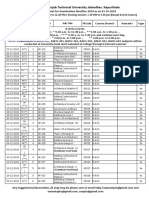MCQ-EC 302 (101 Question)
MCQ-EC 302 (101 Question)
Uploaded by
alokesh1982Copyright:
Available Formats
MCQ-EC 302 (101 Question)
MCQ-EC 302 (101 Question)
Uploaded by
alokesh1982Original Description:
Original Title
Copyright
Available Formats
Share this document
Did you find this document useful?
Is this content inappropriate?
Copyright:
Available Formats
MCQ-EC 302 (101 Question)
MCQ-EC 302 (101 Question)
Uploaded by
alokesh1982Copyright:
Available Formats
Semiconductors
1. Single-element semiconductors are characterized by atoms with ____ valence electrons. A.3 B. 4 C. 5 D.2 E. none of the above 2. Under normal conditions a diode conducts current when it is A.reverse-biased. B. forward-biased. C. avalanched. D.saturated. 3. A diode conducts when it is forward-biased, and the anode is connected to the ________ through a limiting resistor. A.positive supply B. negative supply C. cathode D.anode 4. As the forward current through a silicon diode increases, the internal resistance A.increases. B. decreases. C. remains the same.
5. For a forward-biased diode, the barrier potential ________ as temperature increases. A.decreases B. remains constant C. increases
6. An n-type semiconductor material A.is intrinsic. B. has trivalent impurity atoms added. C.has pentavalent impurity atoms added. D.requires no doping.
7. For a forward-biased diode, as temperature is ________, the forward current ________ for a given value of forward voltage.
A.decreased, increases B. increased, increases C. increased, decreases D.decreased, decreases
08. Which statement best describes an insulator? A.A material with many free electrons. B. A material doped to have some free electrons. C.A material with few free electrons. D.No description fits.
09. You have an unknown type of diode in a circuit. You measure the voltage across it and find it to be 0.3 V. The diode might be A.a silicon diode. B. a germanium diode. C. a forward-biased silicon diode. D.a reverse-biased germanium diode.
10. What types of impurity atoms are added to increase the number of conduction-band electrons in intrinsic silicon? A.bivalent B. octavalent C.pentavalent D.trivalent E. none of the above
11. What factor(s) do(es) the barrier potential of a pn junction depend on? A.type of semiconductive material B. the amount of doping C. the temperature D.all of the above E. type of semiconductive material and the amount of doping but not the temperature
12. Reverse breakdown is a condition in which a diode A.is subjected to a large reverse voltage. B. is reverse-biased and there is a small leakage current. C. has no current flowing at all. D.is heated up by large amounts of current in the forward direction.
13. What occurs when a conduction-band electron loses energy and falls back into a hole in the valence band? A.doping B. recombination C. generation D.[NIL]
Diode Applications
14. Each diode in a center-tapped full-wave rectifier is ________ -biased and conducts for ________ of the input cycle. A.forward, 90 B. reverse, 180 C.forward, 180 D.reverse, 90
15. The output frequency of a full-wave rectifier is ________ the input frequency. A.one-half B. equal to C.twice D.one-quarter
16. PIV is which of the following? A.peak input voltage B. peak inverse voltage C. peak immediate voltage D.positive input voltage
17. If the ac supply is 50 Hz, what will be the ripple frequency out of the full-wave rectifier? A.50 Hz
B. 60 Hz C.100 Hz D.120 Hz
18. A silicon diode in a half-wave rectifier has a barrier potential of 0.7 V. This has the effect of A.reducing the peak output voltage by 0.7 V. B. increasing the peak output voltage by 0.7 V. C. reducing the peak input voltage by 0.7 V. D.no effect.
19. If the ac supply is 60 Hz, what will be the ripple frequency out of the half-wave rectifier? A.30 Hz B. 50 Hz C.60 Hz D.120 Hz
20. In the operation of a half-wave rectifier with a capacitor-input filter, the ripple factor can be lowered by ________ the value of the filter capacitor or ________ the load resistors. A.decreasing, decreasing B. decreasing, increasing C. increasing, decreasing D.increasing, increasing
Bjt DEVICES
21. How much is the base-to-emitter voltage of a transistor in the "on" state? A.0 V B. 0.7 V C. 0.7 mV D.Undefined
22. For what kind of amplifications can the active region of the common-emitter configuration be used? A.Voltage B. Current C. Power D.All of the above
23. In the active region, while the collector-base junction is ________-biased, the base-emitter is ________-biased. A.forward, forward B. forward, reverse C.reverse, forward D.reverse, reverse
24. What range of resistor values would you get when checking a transistor for forward- and reverse-biased conditions by an ohmmeter? A.100 to a few k , exceeding 100 k B. Exceeding 100 k , 100 to a few k C. Exceeding 100 k , exceeding 100 k D.100 to a few k , 100 to a few k
25. In which region are both the collector-base and base-emitter junctions forward-biased? A.Active B. Cutoff C.Saturation D.All of the above
26. What does a reading of a large or small resistance in forward- and reverse-biased conditions indicate when checking a transistor using an ohmmeter? A.Faulty device B. Good device C. Bad ohmmeter D.None of the above 27. Determine the value of when = 100. A.1.01 B. 101 C.0.99 D.Cannot be solved with the information provided
28.
= ________ A.IB / IE B. IC / IE C.IC / IB D.None of the above
dc
29. How many carriers participate in the injection process of a unipolar device? B. 2 A.1 C. 0 D.3
30. What are the ranges of the ac input and output resistance for a common-base configuration? A.10 100 , 50 k 1 M B. 50 k 1 M , 10 100 C. 10 100 k , 50 1 k D.None of the above
31. What is the most frequently encountered transistor configuration? A.Common-base B. Common-collector D.Emitter-collector C.Common-emitter
Field-Effect Transistors
32. For a JFET, the value of VDS at which ID becomes essentially constant is the A.pinch-off voltage. B. cutoff voltage. C. breakdown voltage. D.ohmic voltage.
33. The ________ has a physical channel between the drain and source. B. E-MOSFET A.D-MOSFET C. V-MOSFET D.[NIL]
34. What type(s) of gate-to-source voltage(s) can a depletion MOSFET (D-MOSFET) operate with? A.zero B. positive C. negative D.any of the above
35. Midpoint bias for a D-MOSFET is ID = ________, obtained by setting VGS = 0. A.IDSS / 2 B. IDSS / 3.4 C.IDSS
36. On the drain characteristic curve of a JFET for VGS = 0, the pinch-off voltage is A.below the ohmic area. B. between the ohmic area and the constant current area. C. between the constant current area and the breakdown region. D.above the breakdown region.
37. Which of the following devices has the highest input resistance? A.diode B. JFET C.MOSFET D.bipolar junction transistor
38. The value of VGS that makes ID approximately zero is the A.pinch-off voltage. B. cutoff voltage. C. breakdown voltage. D.ohmic voltage.
39. A dual-gated MOSFET is A.a depletion MOSFET. B. an enhancement MOSFET. C. a VMOSFET. D.either a depletion or an enhancement MOSFET.
40. What three areas are the drain characteristics of a JFET (VGS = 0) divided into? A.ohmic, constant-current, breakdown B. pinch-off, constant-current, avalanche C. ohmic, constant-voltage, breakdown
41. The resistance of a JFET biased in the ohmic region is controlled by A.VD. B. VGS. C. VS. D.VDS. 42. High input resistance for a JFET is due to A.a metal oxide layer. B. a large input resistor to the device.
C. an intrinsic layer. D.the gate-source junction being reverse-biased.
43. For a JFET, the change in drain current for a given change in gate-to-source voltage, with the drain-to-source voltage constant, is A.breakdown. B. reverse transconductance. C.forward transconductance. D.self-biasing.
Semiconductor Diodes
44. What does a high resistance reading in both forward- and reverse-bias directions indicate? A.A good diode B. An open diode C. A shorted diode D.A defective ohmmeter
45. Which capacitance dominates in the reverse-bias region? A.depletion B. conversion C. 40 Diffusion D.140 None of the above 46. What is the state of an ideal diode in the region of nonconduction? A.An open circuit B. A short circuit C. Unpredictable D.Undefined
47. What unit is used to represent the level of a diode forward current IF? A.pA B. nA C. A D.mA
48. The diffused impurities with ________ valence electrons are called donor atoms. A.4 B. 3 D.0 C.5
49. What is the range of the operating voltage level for LEDs? A.512 mV B. 1.73.3 V C. 512 V D.2025 V
50. At what kind of operating frequency diffusion or transition is a capacitor represented in parallel with the ideal diode? A.Low frequency B. Moderate frequency C. Mid frequency D.Very high frequency
51. What is the resistor value of an ideal diode in the region of conduction? A.0 B. 5 k C. Undefined D.Infinity
52. Which of the following elements is most frequently used for doping pure Ge or Si? A.Boron B. Gallium C. Indium D.All of the above
53. What is the maximum power rating for LEDs? A.150 mW B. 500 mW C. 1 W D.10 W
54. What is the value of the transition capacitance for a silicon diode when VD = 0? (Choose the best answer.)
A.1 pF B. 3 pF C. 5 pF D.10 pF 55. Which of the following ratings is true? A.Si diodes have higher PIV and narrower temperature ranges than Ge diodes. B. Si diodes have higher PIV and wider temperature ranges than Ge diodes. C. Si diodes have lower PIV and narrower temperature ranges than Ge diodes. D.Si diodes have lower PIV and wider temperature ranges than Ge diodes.
56. Which capacitance dominates in the forward-bias region? A.Diffusion B. Transition C. Depletion D.None of the above
57. In what state is a silicon diode if the voltage drop across it is about 0.7 V? A.No bias B. Forward bias C. Reverse bias D.Zener region
Bipolar Junction Transistors
58. A transistor amplifier has a voltage gain of 100. If the input voltage is 75 mV, the output voltage is: A.1.33 V B. 7.5 V C. 13.3 V D.15 V
59. What is the ratio of IC to IB? A. DC B. hFE C. DC D.either DC or hFE, but not
DC
60. For normal operation of a pnp BJT, the base must be ________ with respect to the emitter
and ________ with respect to the collector. A.positive, negative B. positive, positive C.negative, positive D.negative, negative
61. When a transistor is used as a switch, it is stable in which two distinct regions? A.saturation and active B. active and cutoff C.saturation and cutoff D.none of the above
62. For a silicon transistor, when a base-emitter junction is forward-biased, it has a nominal voltage drop of A.0.7 V. B. 0.3 V. C. 0.2 V. D.VCC. 63. The value of DC A.is fixed for any particular transistor. B. varies with temperature. C. varies with IC. D.varies with temperature and IC.
64. What is the order of doping, from heavily to lightly doped, for each region? A.base, collector, emitter B. emitter, collector, base C. emitter, base, collector D.collector, emitter, base 65. In what range of voltages is the transistor in the linear region of its operation? A.0 < VCE B. 0.7 < VCE < VCE(max) C. VCE(max) > VCE D.none of the above
66. The magnitude of dark current in a phototransistor usually falls in what range? A.mA B. A
C.nA
D.pA
67. The dc load line on a family of collector characteristic curves of a transistor shows the A.saturation region. B. cutoff region. C. active region. D.all of the above
FET Devices
69. What is the level of IG in an FET? A.Zero amperes B. Equal to ID C. Depends on VDS D.Undefined
70. What is the range of an FET's input impedance? A.10 to 1 k B. 1 k to 10 k C. 50 k to 100 k D.1 M to several hundred M
71. Which of the following controls the level of ID? B. VDS A.VGS C. IG D.VDG 72. It is the insulating layer of ________ in the MOSFET construction that accounts for the very desirable high input impedance of the device. A.SiO B. GaAs D.HCl C.SiO2 73. The BJT is a ________ device. The FET is a ________ device. A.bipolar, bipolar B. bipolar, unipolar C. unipolar, bipolar D.unipolar, unipolar
74. The transfer curve is not defined by Shockley's equation for the ________. A.JFET B. depletion-type MOSFET C.enhancement-type MOSFET D.BJT
75. The region to the left of the pinch-off locus is referred to as the ________ region. A.saturation B. cutoff C.ohmic D.All of the above
76. A BJT is a ________-controlled device. The JFET is a ________ - controlled device. A.voltage, voltage B. voltage, current C.current, voltage D.current, current
77. Which of the following FETs has the lowest input impedance? A.JFET B. MOSFET depletion-type C. MOSFET enhancement-type D.None of the above
78. Which of the following applies to MOSFETs? A.No direct electrical connection between the gate terminal and the channel B. Desirable high input impedance C. Uses metal for the gate, drain, and source connections D.All of the above
79. At which of the following is the level of VDS equal to the pinch-off voltage? A.When ID becomes equal to IDSS B. When VGS is zero volts C. IG is zero D.All of the above
80. Which of the following input impedances is not valid for a JFET?
A.1010 B. 109 C.108 D.1011
Special-Purpose Diodes
81. Schottky diodes are also known as A.PIN diodes. B. hot carrier diodes. C. step-recovery diodes. D.tunnel diodes.
82. Zener diodes with breakdown voltages less than 5 V operate predominantly in what type of breakdown? A.avalanche B. zener C. varactor D.Schottky
83. The Schottky diode is used A.in high-power circuits. B. in circuits requiring negative resistance. C.in very fast-switching circuits. D.in power supply rectifiers.
84. You have an application for a diode to be used in a tuning circuit. A type of diode to use might be A.an LED. B. a Schottky diode. C. a Gunn diode. D.a varactor.
85. What kind of diode is formed by joining a doped semiconductor region with a metal? A.laser B. tunnel C. pin D.Schottky
86. Which diode employs graded doping?
A.zener C. tunnel
B. LED D.step-recovery
87. LEDs are made out of A.silicon. B. germanium. C.Gallium Arsenide. D.silicon and germanium, but not gallium.
88. The normal operating region for a zener diode is the A.forward-bias region. B. reverse-bias region. C. zero-crossing region. D.reverse-breakdown region.
89. The process of emitting photons from a semiconductive material is called A.photoluminescence. B. gallium arsenide. C.electroluminescence. D.gallium phosphide.
90. What type of diode maintains a constant current? A.LED B. zener C.current regulator D.pin E. none of the above
91. Back-to-back varactor diodes are used for what reason? A.over-voltage protection B. a wider tuning range C.to eliminate harmonic distortion D.no reason; only zeners are used in a back-to-back configuration
92. A tunnel diode is used A.in high-power circuits. B. in circuits requiring negative resistance. C. in very fast-switching circuits.
D.in power supply rectifiers.
93. A laser diode normally emits A.coherent light. B. monochromatic light. C.coherent and monochromatic light. D.neither coherent nor monochromatic light.
Thyristors
94. The ________ can be externally programmed to turn on at a desired anode-to-gate voltage level. A.UJT B. PUT C. SCR D.SCS
95. The silicon-controlled switch (SCS) is similar in construction to the A.triac. B. diac. C.SCR. D.4-layer diode. 96. The ________ can conduct current in either direction and is turned on when a breakover voltage is exceeded. A.SCR B. diac C. SCS D.triac
97. You need to design a relaxation oscillator circuit. The most likely device to use might be A.an SCR. B. a UJT. C. a triac. D.a 4-layer diode.
98. You have the schematic diagram of several types of circuits. Which of these circuits most likely uses a triac? A.an oscillator
B. an ac motor control C. a programmable oscillator D.an amplifier
99. The SCR can be triggered on by a pulse at the A.gate. B. anode. C. cathode. D.none of the above 100. How many semiconductor layers are thyristors constructed with? A.2 B. 3 D.5 C.4
101. Your boss has asked you to recommend a thyristor that will enable you to turn it on with a pulse and also turn it off with a pulse. Which of the following should you recommend? A.an SCR B. an SCS C. a PUT D.a triac
You might also like
- Q& A Electronic DevicesDocument39 pagesQ& A Electronic DevicesMUHAMMED SHAMVILNo ratings yet
- Smart SeriesDocument3 pagesSmart SeriesShahhussain Hussain100% (1)
- Practice Test: Question Set - 01Document47 pagesPractice Test: Question Set - 01Roshnal BluestacksNo ratings yet
- Soluforce RLP 2012-10B PDFDocument16 pagesSoluforce RLP 2012-10B PDFIan PillayNo ratings yet
- ECE - Diodes QuestDocument10 pagesECE - Diodes QuestSathyanatha PrabhuNo ratings yet
- Unit - I Electronic Components & Signals: 22225 BEC MCQ (Basic Electronics) Chapter-WiseDocument9 pagesUnit - I Electronic Components & Signals: 22225 BEC MCQ (Basic Electronics) Chapter-WiseShobhit KumarNo ratings yet
- Indiabix Semiconductor Diode FullDocument12 pagesIndiabix Semiconductor Diode FullTons Medina100% (1)
- Last Area Day 8 - Basic Electronics KTC-1Document7 pagesLast Area Day 8 - Basic Electronics KTC-1ellajanepoNo ratings yet
- Excellent Online Test Series Ee (2017) : Technical Academy Pvt. LTDDocument23 pagesExcellent Online Test Series Ee (2017) : Technical Academy Pvt. LTDsayedNo ratings yet
- Electronics 100 Important MCQ PDFDocument22 pagesElectronics 100 Important MCQ PDFRaghu Veer KNo ratings yet
- Transmission and Distribution ExamvedaDocument11 pagesTransmission and Distribution Examvedamirzamusharf2018No ratings yet
- Network Analysis Mcqs Unit 01 & 02 Basics of Network & Network TheoremsDocument6 pagesNetwork Analysis Mcqs Unit 01 & 02 Basics of Network & Network TheoremsPankaj KaleNo ratings yet
- Commutation SCRDocument4 pagesCommutation SCRAmit ParchakeNo ratings yet
- Current & Hysteresis Losses (4) Same Value For Any Type of CoreDocument38 pagesCurrent & Hysteresis Losses (4) Same Value For Any Type of CoreDeepak Choudhary DCNo ratings yet
- Objective QuestionsDocument26 pagesObjective QuestionsAbid GandapurNo ratings yet
- Analog and Digital MCQ 1Document7 pagesAnalog and Digital MCQ 1Akshay KarmareNo ratings yet
- Tle Exam - Basic ElectronicsDocument12 pagesTle Exam - Basic Electronicsbabylyn akilNo ratings yet
- Fundamentals of Electrical Engineering Mcqs PDFDocument3 pagesFundamentals of Electrical Engineering Mcqs PDFrajashekar reddy nallalaNo ratings yet
- Electronics MCQDocument4 pagesElectronics MCQHary KrizNo ratings yet
- Construction of DC MachineDocument10 pagesConstruction of DC MachineMohamed IbrahemNo ratings yet
- Embedded QuizDocument5 pagesEmbedded QuizJagan VNo ratings yet
- Te Unit-2 MCQ PDFDocument10 pagesTe Unit-2 MCQ PDFRajNo ratings yet
- Chapter 3 BJT DevicesDocument22 pagesChapter 3 BJT DevicesDaNieL RuPErTONo ratings yet
- P N JUNCTION DIODE Multiple Choice Questions - 2Document2 pagesP N JUNCTION DIODE Multiple Choice Questions - 2Ssgn SrinivasaraoNo ratings yet
- Bpe MCQDocument80 pagesBpe MCQSaquibh ShaikhNo ratings yet
- MCQs of EC Electrical N ElectronicsDocument22 pagesMCQs of EC Electrical N ElectronicsSatish Bojjawar100% (2)
- Semiconductor Devices Conceptual QuestionsDocument6 pagesSemiconductor Devices Conceptual QuestionsRicha Nawani KaushikNo ratings yet
- Network Analysis Mcqs Unit 01 & 02 Basics of Network & Network TheoremsDocument6 pagesNetwork Analysis Mcqs Unit 01 & 02 Basics of Network & Network TheoremsPankaj KaleNo ratings yet
- Op AmpsDocument22 pagesOp AmpsKrishnaveni DhulipalaNo ratings yet
- Electrical Questions of Nts Before Lesco: Node VDocument15 pagesElectrical Questions of Nts Before Lesco: Node Vcareem uberNo ratings yet
- Electrical Drives MCQDocument7 pagesElectrical Drives MCQSaber AbdelaalNo ratings yet
- Half Wave RectifierDocument17 pagesHalf Wave RectifierNishanthi BheemanNo ratings yet
- Lab Exam MCQsDocument12 pagesLab Exam MCQsShivansh LaadNo ratings yet
- 2. Voltage Regulation of Synchronous GeneratorsDocument8 pages2. Voltage Regulation of Synchronous GeneratorsAmjad HassanNo ratings yet
- Semiconductor MCQ and AnswerDocument21 pagesSemiconductor MCQ and AnswerShakawat Hossain ShifatNo ratings yet
- AC Machinery Lecture 1Document52 pagesAC Machinery Lecture 1Derrick ReyesNo ratings yet
- Rectifier and ConverterDocument10 pagesRectifier and ConverterRaj PatelNo ratings yet
- Ece MCQDocument20 pagesEce MCQHcv Prasad Kacharla100% (1)
- MCQ Electrical TransormerDocument28 pagesMCQ Electrical TransormerEng Mohammed AdelNo ratings yet
- Electronic MCQDocument15 pagesElectronic MCQSachin KumarNo ratings yet
- Assignment - 03 Power Electronics: S. The Auxiliary SCR 2 Should UndergoDocument2 pagesAssignment - 03 Power Electronics: S. The Auxiliary SCR 2 Should UndergoAlis KananiNo ratings yet
- TRANSDUCERS QUIZ ELECTRONICS & INSTRUMENTATION Practice Tests Objective Tests Free Download Many Online Tests Exams For India ExamsDocument9 pagesTRANSDUCERS QUIZ ELECTRONICS & INSTRUMENTATION Practice Tests Objective Tests Free Download Many Online Tests Exams For India Examshemavathi114071No ratings yet
- Thyristor CKT MCQSDocument7 pagesThyristor CKT MCQSAmit ParchakeNo ratings yet
- Control System MCQDocument29 pagesControl System MCQAdarsh JhaNo ratings yet
- Multiple Choice Questions and Answers On Semiconductor Diode - Electronics PostDocument8 pagesMultiple Choice Questions and Answers On Semiconductor Diode - Electronics PostDurga DeviNo ratings yet
- Utilization of Electrical Energy MCQ PDFDocument4 pagesUtilization of Electrical Energy MCQ PDFaijaz aliNo ratings yet
- Network Synthesis Model ExitDocument10 pagesNetwork Synthesis Model ExitERMIAS AmanuelNo ratings yet
- Basic Electrical EngineeringDocument68 pagesBasic Electrical Engineeringahg#No ratings yet
- Module 04 Electronics Fundamentals Aircraft License ComDocument70 pagesModule 04 Electronics Fundamentals Aircraft License ComMohamad Nadzmi100% (1)
- TronicsDocument4 pagesTronicsJustin Angelo SildoraNo ratings yet
- BEE All Unit MCQS'Document40 pagesBEE All Unit MCQS'GAURAV GUPTANo ratings yet
- Unit-I: Diode Circuits: PES's Modern College of Engineering, Department of Electronics & Telecommunication EngineeringDocument23 pagesUnit-I: Diode Circuits: PES's Modern College of Engineering, Department of Electronics & Telecommunication Engineering1514VARAD DUDHALMALNo ratings yet
- 7 Cells and Batteries ITI 1st Year Electrician Theory MCQ MarathiDocument6 pages7 Cells and Batteries ITI 1st Year Electrician Theory MCQ Marathiadj179543No ratings yet
- Take Transformers MCQ Test & Online Quiz To Test Your KnowledgeDocument5 pagesTake Transformers MCQ Test & Online Quiz To Test Your Knowledgexuyen tranNo ratings yet
- Electric Circuits EE 3Document71 pagesElectric Circuits EE 3akshaypokale7777No ratings yet
- Experiment 12 The Universal Motor ObjectiveDocument5 pagesExperiment 12 The Universal Motor ObjectiveFahad IbrarNo ratings yet
- Applied ElectronicsDocument12 pagesApplied ElectronicsEyoab TarikuNo ratings yet
- Apllied Electronics EduDocument10 pagesApllied Electronics EdudagnewcheklieNo ratings yet
- Pre-Board Examination Electronics Engineering SET A: University of San AgustinDocument8 pagesPre-Board Examination Electronics Engineering SET A: University of San AgustinRoyce SumagaysayNo ratings yet
- EeeeeeDocument9 pagesEeeeeeamelia99No ratings yet
- Quantum DerivesDocument1 pageQuantum Derivesalokesh1982No ratings yet
- Wave Particle DualityDocument1 pageWave Particle Dualityalokesh1982No ratings yet
- Frequency: Is Considered The Father of The Quantum TheoryDocument1 pageFrequency: Is Considered The Father of The Quantum Theoryalokesh1982No ratings yet
- SuperconductorsDocument1 pageSuperconductorsalokesh1982No ratings yet
- Passband Modulation: Modulation From Wikipedia, The Free Encyclopedia For Other Uses, SeeDocument3 pagesPassband Modulation: Modulation From Wikipedia, The Free Encyclopedia For Other Uses, Seealokesh1982No ratings yet
- Silicon, (Si) :the Most Common Semiconductor, Atomic Number 14Document1 pageSilicon, (Si) :the Most Common Semiconductor, Atomic Number 14alokesh1982No ratings yet
- History of Quantum PhysicsDocument1 pageHistory of Quantum Physicsalokesh1982No ratings yet
- Quantum Mechanics (QM Also Known As Quantum Physics or Quantum Theory), IncludingDocument1 pageQuantum Mechanics (QM Also Known As Quantum Physics or Quantum Theory), Includingalokesh1982No ratings yet
- History of Z TransformDocument1 pageHistory of Z Transformalokesh1982No ratings yet
- Region of Convergence Example 2: Inverse Z-TransformDocument1 pageRegion of Convergence Example 2: Inverse Z-Transformalokesh1982No ratings yet
- Rabindranath TagoreDocument1 pageRabindranath Tagorealokesh1982No ratings yet
- Acoustic Intravalley Scattering at Low TemperaturesDocument1 pageAcoustic Intravalley Scattering at Low Temperaturesalokesh1982No ratings yet
- OpticalDocument2 pagesOpticalalokesh1982No ratings yet
- One DimensionalDocument1 pageOne Dimensionalalokesh1982No ratings yet
- Multi Potential ScatteringDocument1 pageMulti Potential Scatteringalokesh1982No ratings yet
- Intervalley Phonon Scattering: Harrison56 Conwell67Document1 pageIntervalley Phonon Scattering: Harrison56 Conwell67alokesh1982No ratings yet
- Magnets: Antiferromagnet. Magnetite (FeDocument1 pageMagnets: Antiferromagnet. Magnetite (Fealokesh1982No ratings yet
- 3.3.2 Ionized Impurity Scattering: Brooks51Document1 page3.3.2 Ionized Impurity Scattering: Brooks51alokesh1982No ratings yet
- Optical Intravalley Scattering: Harrison56Document1 pageOptical Intravalley Scattering: Harrison56alokesh1982No ratings yet
- Cadet Admission Test For October 29, 2017: Philippine National Police AcademyDocument16 pagesCadet Admission Test For October 29, 2017: Philippine National Police AcademyPhilBoardResultsNo ratings yet
- Moles To Particles WorksheetDocument2 pagesMoles To Particles WorksheetJaylin LovelessNo ratings yet
- Hydrazine Formate ReductionsDocument3 pagesHydrazine Formate ReductionsPedro Mendonca100% (1)
- Distribution of Polycyclic Aromatic Hydrocarbons (Pahs) in Surface Sediments of Kapas Island, Terengganu, MalaysiaDocument6 pagesDistribution of Polycyclic Aromatic Hydrocarbons (Pahs) in Surface Sediments of Kapas Island, Terengganu, Malaysiajonida88No ratings yet
- Watanabe1989-Analysis of ATP and Its Breakdown Products in Beefby Reversed-Phase HPLCDocument4 pagesWatanabe1989-Analysis of ATP and Its Breakdown Products in Beefby Reversed-Phase HPLChimmafirdausNo ratings yet
- Content Marketed & Distributed By: Equilibrium - IDocument9 pagesContent Marketed & Distributed By: Equilibrium - IxanshahNo ratings yet
- Introduction To Surface Chemistry and CatalysisDocument682 pagesIntroduction To Surface Chemistry and CatalysisSin Kaf91% (11)
- Standing Waves Per Unit Volume-Derivation-blackbody RadiationDocument19 pagesStanding Waves Per Unit Volume-Derivation-blackbody RadiationRachit MadanNo ratings yet
- Tifr Dec2011 Question PaperDocument15 pagesTifr Dec2011 Question Papertvsagar830% (1)
- Technical Manual - Sheffield BioscienceDocument43 pagesTechnical Manual - Sheffield Biosciencenicoagudelo82No ratings yet
- Reverse Osmosis Desalination Plant in Nuweiba City (Case Study)Document16 pagesReverse Osmosis Desalination Plant in Nuweiba City (Case Study)RonaldNo ratings yet
- Method-Ct (Lab 1)Document4 pagesMethod-Ct (Lab 1)Berry101No ratings yet
- Lagrangian FormulationDocument7 pagesLagrangian FormulationAdrian ArasuNo ratings yet
- Structural Analysis of Ladder Chassis Frame For Jeep Using AnsysDocument7 pagesStructural Analysis of Ladder Chassis Frame For Jeep Using AnsysIJMERNo ratings yet
- Valence Electrons: Worksheet On Chemical BondingDocument9 pagesValence Electrons: Worksheet On Chemical BondingTrisha GolesNo ratings yet
- Instructions For Authors: Scope of JournalDocument2 pagesInstructions For Authors: Scope of JournalMr. R. Deepak Joel Johnson MECH-ResearchNo ratings yet
- Alendronate SodiumDocument33 pagesAlendronate SodiumcesarNo ratings yet
- Fisheries Science 2001 InoueDocument8 pagesFisheries Science 2001 InoueKaritoNo ratings yet
- PDFDocument161 pagesPDFKajal HeerNo ratings yet
- Project Helpers - Importance of Electrolysis in Our Daily Lives PDFDocument8 pagesProject Helpers - Importance of Electrolysis in Our Daily Lives PDFCarla WashingtonNo ratings yet
- Construction and Building Materials: Hwang Chao-Lung, Bui Le Anh-Tuan, Chen Chun-TsunDocument5 pagesConstruction and Building Materials: Hwang Chao-Lung, Bui Le Anh-Tuan, Chen Chun-TsunEmanuel CarvalhoNo ratings yet
- Ujian 1 Biologi Form 4Document12 pagesUjian 1 Biologi Form 4edain84No ratings yet
- Design Recommendations For Subsurface Flow Constructed Wetlands For Nitrification and Denitrification - PlatzerDocument9 pagesDesign Recommendations For Subsurface Flow Constructed Wetlands For Nitrification and Denitrification - PlatzertainamagalhaesNo ratings yet
- MBIO 3812 Environmental Isolate ReportDocument4 pagesMBIO 3812 Environmental Isolate ReportBryan ChenNo ratings yet
- Conductometric TitrationDocument5 pagesConductometric TitrationChayon Mondal100% (2)
- Narada 12NDF155 - Bateria PDFDocument2 pagesNarada 12NDF155 - Bateria PDFlucasgcbaNo ratings yet
- Oral PowdersDocument15 pagesOral Powdersintan permata putri0% (1)
- Steel Balls - DanaherDocument23 pagesSteel Balls - DanaherGori BannNo ratings yet













